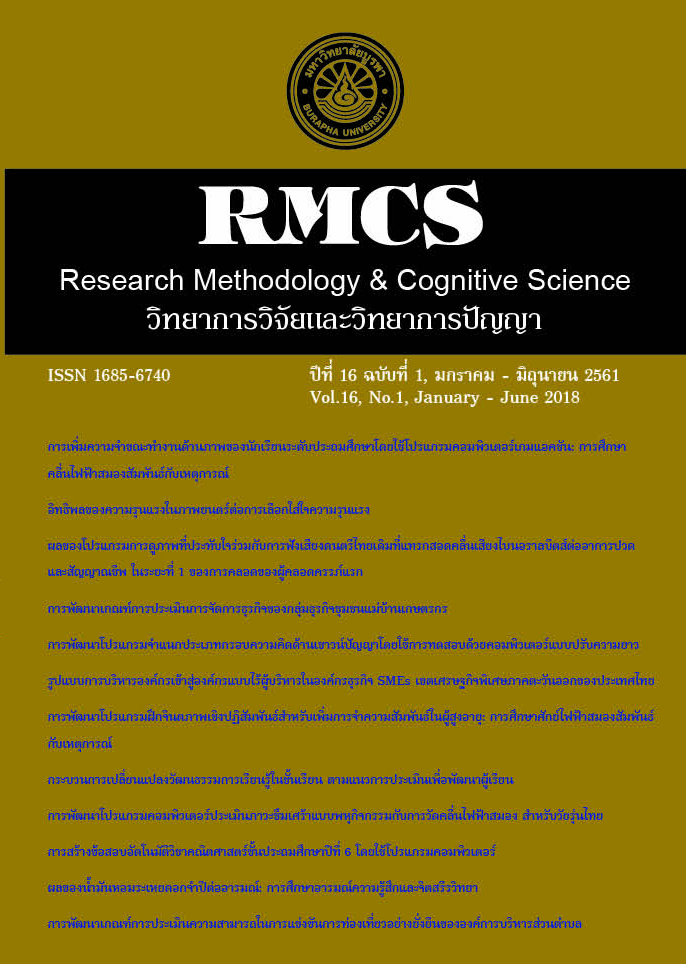Enhancing Visual Working Memory in Primary School Students Using a Computer-Based Action Game: An Event-Related Potential Study
Main Article Content
Abstract
The research aimed 1) to develop a computer-based action game by applied the Cognitive Theory of Multimedia Learning with primary school students, 2) to compare the mean score of accuracy and reaction time while testing visual working memory between before, and after experiment in action game group, 3) to compare the mean of P300 amplitude and the mean of P300 latency while testing visual working memroy between before and after experiment in action game group, 4) to compare the mean score of accuracy and reaction time while testing visual working memroy after experiment between two groups. And 5) to compare the mean of P300 amplitude and the mean of P300 latency while testing visual working memory after experiment between two groups. The participants were 49 primary school students whose age were between 10-11 years old. They were randomly assigned in to two experimental groups: First group trained with computer action game with 25 participants, while second group trained with non-action game with 24 participants. The research instruments were computer-based action game and non-action game, test of visual working memory, and the neuroscan systems. Data were analyzed using descriptive statistic and t-test. The results demonstrated that after the experiment, the action game group possessed a higher mean score of accuracy than before experiment (p< .01). The mean reaction time after the experiment was lower than before the experiment (p< .01). In addition, after the experiment, the action game and the non-action game groups had lower means for P300 amplitude, and also for the mean of P300 latency than before the experiment at the frontal lobe (FPz and Fz), at the parietal lobe (Pz, POz, FCz, Cz and CPz), and at the occipital lobe (Oz) (p< .01). Furthermore, after the experiment the mean of P300 amplitude and the mean of P300 latency of the action game group were lower than the non-action game group in the frontal lobe (FPz and Fz), the parietal lobe (Pz and POz) and the occipital lobe (Oz) (p< .05). In conclusion, the possibility of enhancing the efficient visual working memory of primary school students was achieved by continuously practice with the computer-based action game develpoed by the application of the Cognitive Theory of Multimedia Learning.
Article Details
References
บุราณี ระเบียบ และสุชาดา กรเพชรปาณี. (2559). การพัฒนาโปรแกรมฝึกการคิดเลขโดยประยุกต์โมเดลทริปเพิลโคดสำหรับเพิ่มความจำขณะทำงานของนักเรียนชั้นประถมศึกษาปีที่ 1. วิทยาการวิจัยและวิทยาการปัญญา, 14(2), 102-113.
Akilli, G. K., & Cagiltay, K. (2006). An instructional design/development model for the creation of game-like learning environments: The FIDGE model. Affective and Emotional Aspects of Human-Computer Interaction: Game- Based and Innovative Learning,1(1), 93-112.
Baddeley, A. (2000). The episodic buffer: A new component of working memory?,. Trends in Cognitive Science, 4(11), 417-423.
Blacker, K. J., Curby, K. M., Klobusicky, E., & Chein, J. M. (2014). Effects of action video game training on visual working memory. Journal of Experimental Psychology: Human Perception and Performance, 40(5), 1992-2004.
Boot, W. R., Kramer, A. F., Simons, D. J., Fabiani, M., & Gratton, G. (2008). The effects of video game playing on attention, memory, and executive control. Acta Psychologica, 129(3), 387-398.
Buelow, M. T., Okdie, B. M., & Cooper, A. B. (2015). The influence of video games on executive functions in college students. Computers in Human Behavior, 45(1), 228-234.
Colzato, L. S., van den Wildenberg, W. P. M., Zmigrod, S., & Hommel, B. (2013). Action video gaming and cognitive control: Playing first person shooter games is associated with improvement in working memory but not action inhibition. Psychological Research Psychologist Forschung, 77(2), 234-239.
Diamond, A., & Lee, K. (2011). Interventions shown to aid executive function development in children 4 to 12 years old. Science, 333(6045), 959-964.
Hardy, L. H., Rand, G., & Rittler, M. C. (1945). Tests for the detection and analysis of color-blindness. I. The Ishihara test: an evaluation. JOSA, 35(4), 268-275.
Kuhn, S., Gleich, T., Lorenz, R. C., Lindenberger, U., & Gallinat, J. (2014). Playing super Mario induces structural brain plasticity: Gray matter changes
resulting from training with a commercial video game. Molecular Sychiatry, 19(2), 265-271.
Klingberg, T., Fernell, E., Olesen, P. J., Johnson, M., Gustafsson, P., & Dahlstrom, K.. (2005). Computerized training of working memory in children with ADHD A randomized, controlled trial. Journal of the American Academy of Child and Adolescent Psychiatry, 44(2), 177-186.
Mayer, R. E. (2009). Multimedia learning(2nd ed.). Cambridge: Cambridge university press.
McMillan, J. H., & Schumacher, S. (2014). Research in education: Evidence-based inquiry. Boston: Pearson Higher Education.
Nussbaumer, D., Grabner, R. H., & Stern, E. (2015). Neural efficiency in working memory tasks: The impact of task demand. Intelligence, 50(1), 196-208.
Poliny Ung, & Suchada Kornpetpanee. (2560). การพัฒนาแบบจำลองการติดตามหลายวัตถุทรงเหลี่ยมเคลื่อนที่แบบสามมิติ (3D-MBTM) สำหรับเพิ่มความสามารถด้านมิติสัมพันธ์ของวัยรุ่นตอนต้น.วิทยาการวิจัยและวิทยาการปัญญา, 15(2), 12-24.
Rosenbaum, J. G. (1984). The biggest reward for my invention isn’t money. Medical Economics, 61, 152-163

